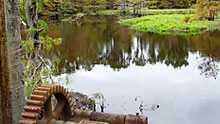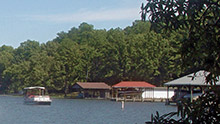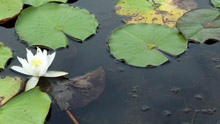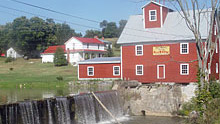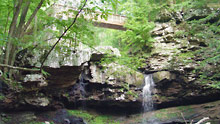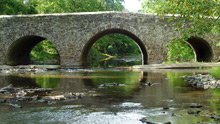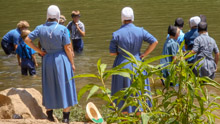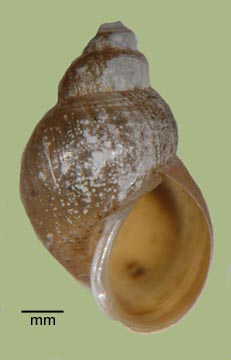Fossaria or Galba cubensis, viator, etc.
> Habitat & Distribution
Baker (1911) considered L. cubensis/viator (in the narrow sense) typically a tropical species. He cited quite a few records from Mexico, South America and the West Indies, but had very spotty data from the US: Florida, Georgia, Louisiana and Texas only. Hubendick (1951) reported essentially the same range as Baker. More recently it has become clear that L. cubensis ranges through the Piedmont and Coastal Plain of Georgia and the Carolinas, across North Alabama, and (counting all its likely synonyms) through the western United States from the Mississippi River to the Pacific Northwest (Alda et al. 2021).
Our data on the freshwater gastropods of The Great Plains suggest that L. cubensis/viator is quite common and widespread in Kansas, disappearing in Nebraska and further north.
Adult Lymnaea cubensis/viator are quite amphibious, apparently spending a substantial fraction of their lives grazing on mud above the water level. Populations typically colonize ditches, vernal ponds, and the muddy margins of larger coastal plain rivers. See my essay of 26May17 for more about the discovery of nine individual L. cubensis/viator transported into Louisiana by a migrating indigo bunting (Zenzal et al. 2017). FWGNA incidence rank I-3p, peripheral in our study area.
> Ecology & Life History
Lymnaea cubensis/viator is one of several smaller-bodied, amphibious ( fossarine ) lymnaeid taxa capable of serving as an intermediate host for trematodes causing fascioliasis in livestock, and rarely humans (Bargues et al. 2007). This has attracted significant parasitological interest in the entire worldwide subgenus (or Genus) Galba. For reviews of the large literature, see Mas-Coma and colleagues (2005, 2009).
As seems to be the case throughout the subgenus Galba, populations of L. cubensis/viator apparently reproduce primarily by self-fertilization (Lounnas et al. 2017). For a review of the literature that has accumulated on the population genetics of the fossarine lymnaeids, see my essay of 22June21 from the link below.
It is possible that the worldwide research emphasis focused on the genetics of L. cubensis/viator populations has led to understudy of their ecology and life history. Our very informal observations suggest that reproduction occurs year-round, that maturation is relatively rapid, and that fecundities are relatively large. I am not aware of any actual data bearing on these questions, however.
Levri et al. (2014) analyzed growth rates and mortalities in laboratory populations identifed as being in the "Fossaria bulimoides group" as a control for experimental populations of Potamopyrgus antipodarum.
> Taxonomy & Systematics
Here in the USA, the taxonomy of L. cubensis (in its narrow sense) has historically been elaborately entangled with that of L. humilis, a similarly small, amphibious species more northern in its distribution. Baker (1911) was the first to distinguish the two species by the number of cusps on their first marginal tooth, humilis with three and cubensis with two. It seems likely, however, that the specimens in Thomas Say s hand when he described humilis in 1822 were not tricuspid, but rather from a bicuspid population collected near Charleston, South Carolina. For that reason, we recommend that the type locality for L. humilis be restricted to the Susquehanna River at Owego, NY, where populations are entirely tricuspid. See my essay of 25June08 from the link below.
Baker s original (1911) classification of the Lymnaeidae assigned cubensis (together with at least 60 80 other specific nomina) to a large, inclusive genus Galba (Schrank 1803), which he later (1928) subdivided and emended to Fossaria (Westerlund 1885). Burch (1989) followed Baker (1928), gathering cubensis together with ten other nominal species and subspecies of small, bicuspid lymnaeids into the genus Fossaria, subgenus Bakerilymnaea (Weyrauch). Meanwhile, European consensus continued to favor Galba.
Quite a few molecular phylogenies have been published in recent years involving L. humilis, L. cubensis, and many other lymnaeid taxa worldwide (e.g., Bargues & Mas-Coma 1997, Remigio 2002, Correa et al. 2010, 2011). See my post to the FWGNA blog of 4June12 from the link below for a critical examination of this literature. It continues to be our impression that the simple classification system of Hubendick (1951) fits the available data best. See my essay of 28Dec06 available from the link below for more.
More recently, large-scale surveys of morphological divergence, multiplex PCR genotype, and DNA sequence variation have thrown significantly more light on evolutionary relationships in the worldwide genus Galba (Alda et al. 2018, 2021). It now appears that the 11 taxa gathered together under Burch's subgenus Bakerilymnaea boil down to just three, dalli (Baker 1907) and perplexa (Baker & Henderson 1929) synonymous with cubensis (Pfeiffer 1839). A great number of nominal species described from South and Central America are synonymous as well.
The oldest name for the entire New World fauna of small, amphibious lymnaeids with bicuspid first marginal teeth now appears to be Lymnaea (Galba) viator, proposed by d Orbigny (1835) for South American populations four years before Pfeiffer described L. cubensis. Rather than running the risk of losing the large literature currently indexed under the name cubensis by synonymy, however, we have advocated identifying this group with the slash-name, L. cubensis/viator. For more, see my essay of 6July21 from the link below.
> Maps and Supplementary Resources
- Lymnaea cubensis distribution in Atlantic drainages (2023)
- Lymnaea distribution in Georgia and the Florida panhandle (2025)
- Lymnaea distribution in the Tennessee/Cumberland (2022)
- Distribution of Lymnaea (Galba) in The Great Plains (2024)
> Essays
- See my post to the FWGNA blog of 28Dec06 for a review of The Classification of the Lymnaeidae.
- I reviewed the taxonomic histories of L. humilis and L. cubensis in my post of 25June08, entitled The Type Locality of Lymnaea humilis. I have also made available photos comparing the radulae of these two very similar species.
- See my essay of 4June12 for a review of the large molecular phylogenetic literature that had accumulated on the Lymnaeidae as of that date, The Lymnaeidae 2012: Stagnalis yardstick.
- I revisited the systematics and taxonomy of L. cubensis and related species worldwide in my blog post of 7Aug12, "The Lymnaeidae 2012: Fossarine football."
- On 26May17 I shared the remarkable discovery of 9 adult L. cubensis transported in the breast feathers of a migrating indigo bunting. See Freshwater Snails and Passerine Birds.
- I reviewed the entire worldwide fauna of crappy-little amphibious lymnaeids in 7June21, The American Galba and The French Connection. That post featured a couple nice comparative figures of shell and radula.
- Reproductive mode was the focus of my essay of 22June21, The American Galba: Sex, Wrecks, and multiplex. That post reviewed the new multiplex PCR test we developed to distinguish G. cubensis, G. truncatula, and G. schirazensis.
- In my post of 6July21 I reviewed the results of the big international research effort of Alda and colleagues (2021), Exactly 3ish American Galba. There I proposed to conjoin Pfeiffer s 1839 nomen with that of d Orbigny s 1835 to create the awkward/vivid Latinate amalgam, Lymnaea (Galba) cubensis/viator.
- In my essay of 13Feb24 I finally addressed the rhetorical question, What is Lymnaea bulimoides? We reviewed the history of the nomen as it has been applied to living populations of lymnaeid snails throughout the American West, especially focusing on longstanding confusion with L. cubensis/viator. This essay is essential background for my follow up of 12Mar24, addressing the confusion between L. bulimoides and L. cockerelli, as well the genetic data reviewed in 8Apr25.
- On 12Mar24 I reviewed the evidence confirming Lymnaea (Galba) cockerelli, Number 15 in the FWGNA list of valid biological species of North American lymnaeid snails. That essay included a summary table translating Burch's (1989) five-species, six-subspecies model of the subgenus Bakerilymnaea to the clean, three-species FWGNA model of the subgenus Galba.
- On 8Apr25 I reported DNA sequence data from a bona fide Oregon population of L. bulimoides confirming widespread and persistent confusion between bulimoides, cubensis/viator and cockerelli. See Lymnaea bulimoides, and the NCBI GenDump, with lecture notes on the scientific method. That essay includes a nice figure comparing the three species as well.
> References
Alda, Pilar, M. Lounnas, A.V zquez, R. Ayaqui, M. Calvopi a, M. Celi-Erazo, R.T. Dillon Jr., L. Gonz lez Ram rez, E. Loker, J. Muzzio-Aroca, A. N rvaez, O. Noya, A. Pereira, L. Robles, R. Rodr guez-Hidalgo, N. Uribe, P. David, P. Jarne, J-P. Pointier, & S. Hurtrez-Boussès (2021) Systematics and geographical distribution of Galba species, a group of cryptic and world-wide freshwater snails. Molecular Phylogenetics and Evolution 157: 107035. [pdf] [html]
Alda, Pilar, M. Lounnas, A. V zquez, R. Ayaqui, M. Calvopi a, M. Celi-Erazo, R. T. Dillon, Jr., P. Jarne, E. Loker, F. Pareja, J. Muzzio-Aroca, A. N rvaez, O. Noya, L. Robles, R. Rodr guez-Hidalgo, N. Uribe, P. David, J-P. Pointier, & S. Hurtrez-Bouss s (2018). A new multiplex PCR assay to distinguish among three cryptic Galba species, intermediate hosts of Fasciola hepatica. Veterinary Parasitology 251: 101-105. [pdf] [html].
Baker, F. C. (1911) The Lymnaeidae of North and Middle America, Recent and Fossil. Special Publication No. 3., Chicago: Chicago Academy of Natural Sciences.
Baker, F. C. (1928) Freshwater Mollusca of Wisconsin, Part I, Gastropoda. Bull. Wisc. Geol. Natur. Hist. Survey, no. 70. Madison: University of Wisconsin Press.
Bargues, M.D., and S. Mas-Coma (1997) Phylogenetic analysis of lymnaeid snails based on 18S rDNA sequences. Mol. Bio. Evol. 14: 569 577.
Burch, J. B. (1989) North American Freshwater Snails. Malacological Publications, Hamburg, MI. 365 pp.
Burgarella, C. et al. (2015) Molecular evolution of freshwater snails with contrasting mating systems. Mol. Biol. Evol. 32(9): 2403 - 2416.
Correa, A. C., J. S. Escobar, P. Durand, F. Renaud, P. David, P. Jarne, J-P Pointier, & S. Hurtrez-Bousses (2010) Bridging gaps in the molecular phylogeny of the Lymnaeidae (Gastropoda: Pulmonata), vectors of Fascioliasis. BMC Evolutionary Biology 10: 381.
Correa, A. C., J. S. Escobar, O. Noya, L. E. Velasquez, C. Gonzalez-Ramirez, S. Hurtrez-Bousses, and J. P. Pointier (2011) Morphological and molecular characterization of Neotropic Lymnaeidae (Gastropoda: Lymnaeoidea), vectors of fasciolosis. Infection, Genetics and Evolution 11: 1978-1988.
Ferrer, J. R., G. Perera, M. Yong, & O. Amador. 1989. Life tables of Fossaria cubensis and Pseudosuccinea columella, intermediate hosts of Fasciola hepatica in Cuba. J. Med. Appl. Malacology 1: 189-194.
Hodasi, J. (1972) The effects of Fasciola hepatica on Lymnaea truncatula. Parasitology, 65: 359-369.
Hubendick, B. (1951) Recent Lymnaeidae. Their variation, morphology, taxonomy, nomenclature, and distribution. Kungl. Svenska Vetensk. Akad. Handl., 3, 1-223.
Kendall, S. (1953) The life history of Limnaea truncatula under laboratory conditions. J. Helminth, 27: 17-28.
Levy, M., M. Tunis, & H. Isserhoff. (1973) Population control in snails by natural inhibitors. Nature, 241: 65-66.
Levri, E.P., A.C. Krist, R. Bilka, and M.F. Dybdahl (2014) Phenotypic plasticity of the introduced New Zealand mud Snail, Potamopyrgus antipodarum, compared to sympatric native snails. PLoS ONE 9(4):e93985, 1-6.
Lounnas, M., V zquez, A.A., Alda, P., Sartori, K., Pointier, J.-P., David, P., Hurtrez-Bouss s, S. (2017) Isolation, characterization and population-genetic analysis of microsatellite loci in the freshwater snail Galba cubensis (Lymnaeidae). J. Molluscan Stud. 83: 63 68.
Mas-Coma, S., M. D. Bargues, & M. A. Valero 2005. Fascioliasis and other plant-borne trematode zoonoses. Int. J. Parasit. 35: 1255-1278.
Mas-Coma, S., M.A. Valero, and M. D. Bargues (2009) Fasciola, lymnaeids and human fascioliasis, with a global overview on disease transmission, epidemiology, evolutionary genetics, molecular epidemiology and control. Advances In Parasitology 69: 44 151.
Remigio, E. (2002) Molecular phylogenetic relationships in the aquatic snail genus Lymnaea, the intermediate host of the causative agent of fascioliasis: insights from broader taxon sampling. Parasitol. Res. 88, 687 696.
Remigio, E. A. & D. Blair (1997) Molecular systematics of the freshwater snail family Lymnaeidae (Pulmonata: Basommatophora) utilising mitochondrial ribosomal DNA sequences. J. Moll. Stud. 63: 173-185.
Samadi, S., Roumegoux, A., Bargues, M.D., Mas-Coma, S., Yong, M., & Pointier, J-P. (2000) Morphological Studies of Lymnaeid Snails from the Human Fascioliasis Endemic Zone of Bolivia. J. Molluscan Stud. 66: 31-44.
Trouve', S., L. Degen, F. Renaud & J. Goudet. 2003. Evolutionary implications of a high selfing rate in the freshwater snail Lymnaea truncatula. Evolution 57: 2303-2314.
Zenzal, TJ, Jr, EJ Lain, and JM Sellers (2017) An Indigo Bunting (Passerina cyanea) Transporting Snails During Spring Migration. The Wilson Journal of Ornithology 129: 898 - 902.

